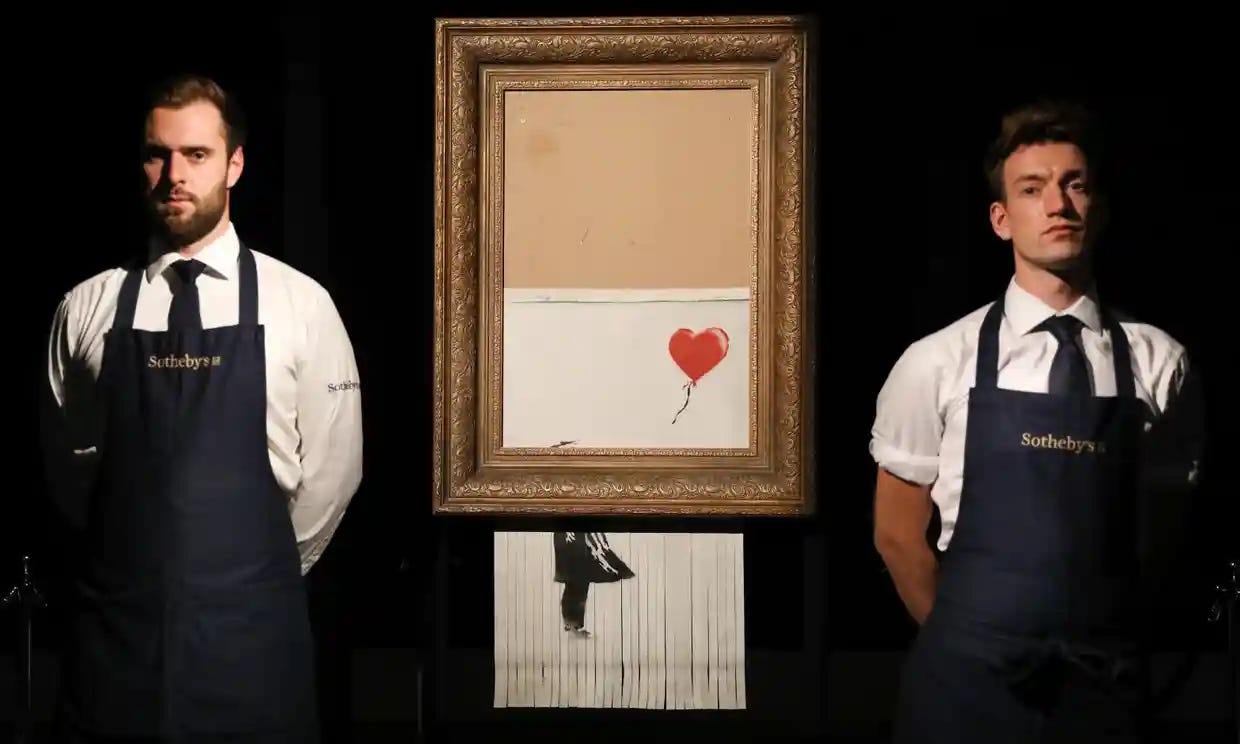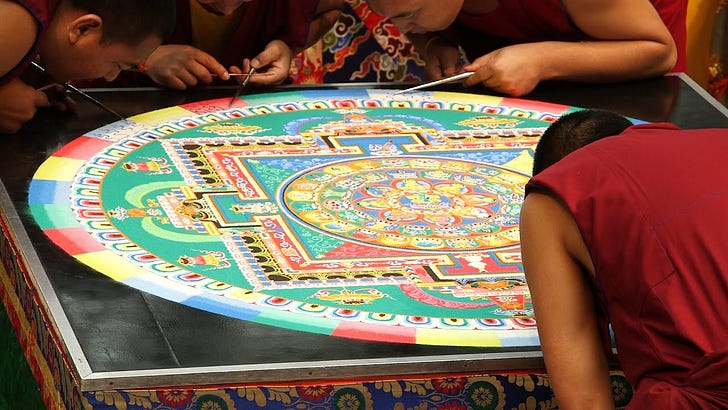When Tibetan monks visited New York, they destroyed a ritually created sand mandala. For the monks, the creation and destruction of a mandala is a deeply spiritual endeavour symbolising impermanence. Nothing lasts forever. During and after creation, visitors took photos and filmed the process. But hadn’t they somehow missed the point? (Video is less than 2 mins long):
There is something contradictory about creating an ephemeral work of art when its transience is caught in the permanence of a photographic image. It could be argued they are two separate entities, but if the value of the process is its impermanence then the photographic process is an act of attachment contrary to the intended purpose of the creation.
According to the Tate gallery, London, ephemeral art is “art which only lasts a short amount of time”.
There are many forms of ephemeral art, from sculpture to performance, but the term is usually used to describe a work of art that only occurs once, like a happening, and cannot be embodied in any lasting object to be shown in a museum or gallery.1
There is no monetary value which can be ascribed to ephemeral art, and its creation is, in many ways, a radical act.

In 1960, George Maciunas founded an international network of artists and musicians, named Fluxus, who rejected the authority of museums and galleries to determine the value of art. Instead, they mocked the elitist world of high art, by creating a more inclusive approach by generating interactive, open-ended experiences. What resulted was a more ephemeral, one time piece, which even if reproduced, would be unique.2 The artists gathered for art events centred primarily in New York, Germany and Japan.
Avant-garde composer, John Cage, a member of Fluxus, is most famous for 4’33”, a composition for piano in three movements. Imagine yourself turning up for a concert. A performer sits at a piano then remains silent, unmoving, for four minutes and thirty seconds. He then stands up, bows and leaves the stage.
John Cage was fascinated by the idea that we can never truly experience silence. His composition invites you to pay attention to the sounds that constantly surround us, but we usually filter out of consciousness. There is an ephemeral quality to each performance, the ambient, atmospheric music dependent on time and place.3
In his composition, Organ As Slow As Possible, John invites the performer, an organist or pianist to play it slow, without giving precise direction on the tempo, leaving it open to the interpretation of the performer. In one rendition, the piece began to be played in 2001 and isn’t due to finish until 2640. You can experience a chord transition in this clip (a little over a minute long):
It is impossible to sit around for the entirety of the composition and experience it as a whole. People turn up for the transitional experience - a change in note, or a chord - something dying, something born.
Fluxus member, Yoko Ono, out of a period of anger and frustration, created Cut Piece, first shown in Japan, 1964. Yoko sat motionless, in a trance state, with a pair of scissors on the floor in front of her. An announcement was made which invited the audience to approach and cut away her clothing. She wore what she described as her best suit - wanting to share and give of her best.4 It was a give and take experience, the audience leaving with the piece of clothing they had cut. The boundary between performer and audience, artist and viewer was blurred. The performance evoked a range of emotional and behavioural reactions in addition to a variety of interpretations.
Of the performance, Yoko herself said:
It was a form of giving, giving and taking. It was a kind of criticism against artists who are always giving what they want to give. I wanted people to take whatever they wanted to, so it was very important to say you can cut wherever you want to. It is a form of giving that has a lot to do with Buddhism. There’s a small allegorical story about Buddha. He left his castle with his wife and children and was walking towards a mountain to go into meditation. As he was walking along, a man said that he wanted Buddha’s children because he wanted to sell them or something. So Buddha gave him his children. Then someone said he wanted Buddha’s wife and he gave him his wife. Someone calls that he is cold, so Buddha gives him his clothes. Finally, a tiger comes along and he wants to eat him and Buddha lets the tiger eat him. And in the moment the tiger eats him, it became enlightened or something. That’s a form of total giving as opposed to reasonable giving like “logically you deserve this” or “I think this is good, therefore I am giving this to you.”
Yoko Ono in interview (1967)5
It has been argued that Yoko Ono cloaked feminist issues within the spirituality of the piece. As performer, the objectification of her body reflected wider societal attitudes and female experience. Yoko denied this as the purpose of the art, but when the audience becomes performer, its meaning is out of the scope of the original artist. Lynn Hershman, also an artist, viewed it in terms of violence and risk. One commentator even described it as rape, which goes against the grain of Yoko’s more spiritual experience: “I felt kind of like I was praying. I also felt that I was willingly sacrificing myself.”6
Cut Piece has been performed many times by Yoko Ono, each presentation in accordance with a different purpose she might have had. In her book, Grapefruit: A Book of Instructions and Drawings she outlined the process for others (with no gender restriction) to perform the same piece, which many have followed, giving the ephemeral work a sense of timelessness. Like the Tibetan mandala sand paintings, these performances have been photographed and filmed, cut up, as one observer commented, much like the clothing in the performance, expressing the viewer perspective of the piece.
Whatever interpretation is favoured, there is little doubt that those who choose to undertake a performance of Cut Piece are irrevocably changed by the experience. Peaches, who performed it in 2013, described it as a very simple concept:
.. but once you are involved in this place, you see how complex and incredible and what a transforming experience is. It is first of all, I’ve never sat still on stage without speaking, so those two things were very new to me. It was incredible because I became the audience and the audience became the performer and I never even thought about that happening …
Merrill Nisker, aka Peaches7
The book Grapefruit feels like a truly democratic collection of one person’s art. In addition to Cut Piece, Yoko Ono invites the reader to create their own art as she has, giving posterity to otherwise ephemeral endeavours.
Draw an imaginary map.
Put a goal mark on the map where you
want to go.
Go walking on an actual street according
to your map.
If there is no street where it should be
according to the map, make one by putting
the obstacles aside.
When you reach the goal, ask the name of
the city and give flowers to the first
person you meet.
The map must be followed exactly, or the
event has to be dropped altogether.Ask your friends to write maps.
Give your friends maps.1962 summer8
Up Next
While Fluxus has itself been lost to time, the fleeting art of the period has a legacy which continues to influence contemporary artists. In next week’s post we will explore the work of an ephemeral artist who works with objects found in natural settings - Andrew Goldsworthy.
Embers
In the spirit of the Fluxus artists, let’s try to create Yoko Ono’s Earth Piece?! I’d love you to share your experience, either in the comments or through Notes (please tag me).
Earth Piece
Listen to the sound of the earth turning.
1963 spring9
https://www.theartstory.org/movement/fluxus/
https://www.classicfm.com/composers/cage/john-organ-chord-change-as-slow-as-possible/
https://en.wikipedia.org/wiki/Cut_Piece_1964
https://www.jstor.org/stable/30135150?seq=9
see note 5
https://www.themarginalian.org/2012/10/30/yoko-ono-grapefruit/
see note 9





Once again Safar, an hugely interesting subject and one I’ve never really given much mind to, though ephemeral art I see daily in nature.. Mother Nature being arguably the greatest of all ephemeral artists; I’m thinking clouds, mist, sunrise, sunset, flowers that bloom for but a few hours before dying… the way a flock of birds fly over a building, in every day life ephemeral art is everywhere if we just stop and think about it for a second.
Does photographing such art make it less ephemeral? I would perhaps say yes and then no! It is human nature to want to remember something with more solid prof than memory, perhaps if we can refine our ability to keep those memories safe and clear there would be no need to make a mirror image - sadly we are not built that way so we snap away, not realising that we are changing the whole sense or reason of what we are seeing in the process. 🤍